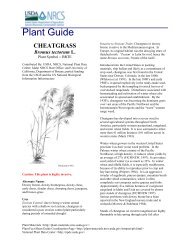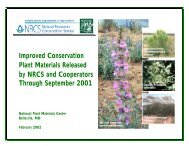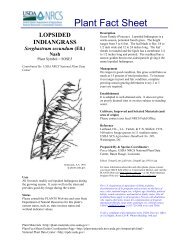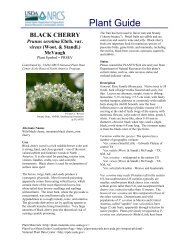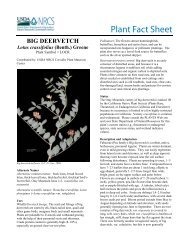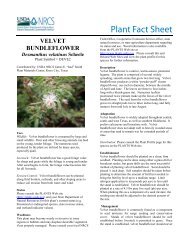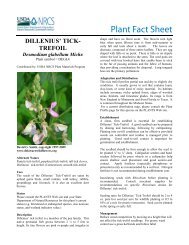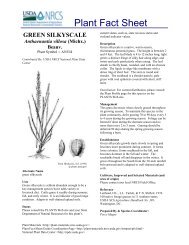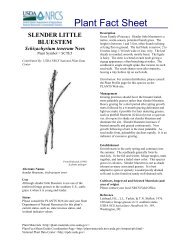yellow coneflower - USDA Plants Database - US Department of ...
yellow coneflower - USDA Plants Database - US Department of ...
yellow coneflower - USDA Plants Database - US Department of ...
You also want an ePaper? Increase the reach of your titles
YUMPU automatically turns print PDFs into web optimized ePapers that Google loves.
YELLOW<br />
CONEFLOWER<br />
Ratibida pinnata (Vent.)<br />
Barnh.<br />
Plant Symbol = RAPI<br />
Contributed by: <strong><strong>US</strong>DA</strong> NRCS National Plant Data<br />
Center<br />
Division <strong>of</strong> Natural Areas and Preserves<br />
Ohio <strong>Department</strong> <strong>of</strong> Natural Resources<br />
Alternative Names<br />
gray-head prairie <strong>coneflower</strong>, drooping <strong>coneflower</strong>,<br />
pinnate prairie <strong>coneflower</strong><br />
Uses<br />
Ethnobotanic: Ratibida pinnata root was used to cure<br />
toothache (Fielder 1975).<br />
Landscaping &Wildlife: Yellow <strong>coneflower</strong> is a<br />
strong survivor <strong>of</strong> former prairies where the majority<br />
<strong>of</strong> the original plants have perished. This is a long<br />
live species and is best to plant where there is<br />
Plant Guide<br />
competition from other plants. The seed heads are<br />
eaten by birds in the late fall. The flowers attract<br />
several different butterfly species.<br />
Status<br />
Please consult the <strong>Plants</strong> Web site and your State<br />
<strong>Department</strong> <strong>of</strong> Natural Resources for this plant’s<br />
current status, such as, state noxious status and<br />
wetland indicator values.<br />
Description<br />
General: Sunflower family (Asteraceae). Yellow<br />
<strong>coneflower</strong> is a native perennial herb growing from a<br />
woody caudex up to one meter or taller. The leaves<br />
are pinnantely compound, mostly with five to seven<br />
lanceolate segments, with harsh and scurfy surfaces<br />
(Bruggen 1976). The disk flowers are usually gray at<br />
first becoming brown with age. When the disk heads<br />
are crushed, an odor <strong>of</strong> anise is emitted. Each flower<br />
has its own stalk and five to eight <strong>yellow</strong>, drooping<br />
petals arranged in a cone shape.<br />
Distribution: Yellow <strong>coneflower</strong> ranges from Ontario<br />
and New York to Minnesota, South Dakota, and<br />
Nebraska, south to Georgia, Arkansas and Oklahoma<br />
(Steyermark 1963). For current distribution, please<br />
consult the Plant pr<strong>of</strong>ile page for this species on the<br />
PLANTS Web site.<br />
Adaptation<br />
This species occurs in prairies, thickets, and borders<br />
<strong>of</strong> woods. It is <strong>of</strong>ten found along roadsides and<br />
railroad right-<strong>of</strong>-ways. Yellow <strong>coneflower</strong> grows<br />
best on loam, clay, and sandy soil types that are from<br />
medium moisture to dry. It prefers calcareous soils<br />
that are neutral pH 6-7, but will grow in sunny<br />
locations with well-drained soils, and is <strong>of</strong>ten found<br />
in wet mesic, mesic and dry mesic sites.<br />
Establishment<br />
Propagation by Seed: Ratibida pinnata seeds are best<br />
planted in the spring or fall. Generally the seeds does<br />
not need any pre-treatment. They can be stratified at<br />
33 to 38ºF for thirty days.<br />
Management<br />
Harvesting <strong>of</strong> seeds should be done from October<br />
through November. The cones should be clipped<br />
form the stem and placed into a bucket to rub the<br />
seeds <strong>of</strong>f the cone to be used for propagation.<br />
Plant Materials <br />
Plant Fact Sheet/Guide Coordination Page <br />
National Plant Data Center
Cultivars, Improved and Selected Materials (and<br />
area <strong>of</strong> origin)<br />
Somewhat available through native plant seed<br />
sources within its range. Contact your local Natural<br />
Resources Conservation Service (formerly Soil<br />
Conservation Service) <strong>of</strong>fice for more information.<br />
Look in the phone book under ”United States<br />
Government.” The Natural Resources Conservation<br />
Service will be listed under the subheading<br />
“<strong>Department</strong> <strong>of</strong> Agriculture.”<br />
References<br />
Bruggen, T. V. 1976. The vascular plants <strong>of</strong> South<br />
Dakota. The Iowa State University Press, Ames,<br />
Iowa.<br />
Fielder, M. 1975. Plant medicine and folklore.<br />
Winchester Press, New York, New York.<br />
Gleason, H. A. 1952. The new Britton and Brown<br />
illustrated flora <strong>of</strong> the northeastern United States and<br />
adjacent Canada. 3 vols. The New York Botanical<br />
Garden, New York, New York.<br />
Grimm, W.C. 1993. The Illustrated book <strong>of</strong><br />
wildflowers and shrubs. Stackpole Books,<br />
Mechanicsburg, PA.<br />
Mohlenbrock, R.H., ed. 1975. Guide to the vascular<br />
flora <strong>of</strong> Illinois. Southern Illinois University Press,<br />
Carbondale, Illinois.<br />
Mohlenbrock, R. H. & J.W. Voight 1959. A flora <strong>of</strong><br />
southern Illinois. Southern Illinois University Press,<br />
Carbondale, Illinois.<br />
Ohio <strong>Department</strong> <strong>of</strong> Natural Resources 2000. Ohio<br />
prairies. Division <strong>of</strong> Natural Areas and Preserves.<br />
Accessed: 11jan02.<br />
<br />
Small, J. K. 1933. Manual <strong>of</strong> the southeastern flora.<br />
The University <strong>of</strong> North Carolina Press, Chapel Hill,<br />
North Carolina.<br />
Steyermark, J. A. 1963. Flora <strong>of</strong> Missouri. The<br />
Iowa State University Press, Ames Iowa.<br />
Swink, F. & G. S. Wilhelm 1979. <strong>Plants</strong> <strong>of</strong> the<br />
Chicago region. 3 rd ed. The Morton Arboretum,<br />
Lisle, Illinois.<br />
The Great Plains Flora Association 1986. Flora <strong>of</strong><br />
the Great Plains. University Press <strong>of</strong> Kansas,<br />
Lawrence, Kansas.<br />
Prepared By<br />
Jammie Favorite<br />
formerly <strong><strong>US</strong>DA</strong>, NRCS, National Plant Data Center<br />
Baton Rouge, Louisiana<br />
Species Coordinator<br />
M. Kat Anderson<br />
<strong><strong>US</strong>DA</strong>, NRCS, National Plant Data Center, c/o Plant<br />
Sciences Dept., Davis, California<br />
Edited: 19jun02 jsp; 30may03 jsp; 060809 jsp<br />
For more information about this and other plants, please contact<br />
your local NRCS field <strong>of</strong>fice or Conservation District, and visit the<br />
PLANTS Web site or the Plant Materials<br />
Program Web site <br />
The U.S. <strong>Department</strong> <strong>of</strong> Agriculture (<strong><strong>US</strong>DA</strong>) prohibits<br />
discrimination in all its programs and activities on the basis <strong>of</strong><br />
race, color, national origin, sex, religion, age, disability, political<br />
beliefs, sexual orientation, and marital or family status. (Not all<br />
prohibited bases apply to all programs.) Persons with disabilities<br />
who require alternative means for communication <strong>of</strong> program<br />
information (Braille, large print, audiotape, etc.) should contact<br />
<strong><strong>US</strong>DA</strong>'s TARGET Center at 202-720-2600 (voice and TDD).<br />
To file a complaint <strong>of</strong> discrimination write <strong><strong>US</strong>DA</strong>, Director, Office<br />
<strong>of</strong> Civil Rights, Room 326-W, Whitten Building, 14th and<br />
Independence Avenue, SW, Washington, DC 20250-9410 or call<br />
202-720-5964 (voice or TDD). <strong><strong>US</strong>DA</strong> is an equal opportunity<br />
provider and employer.<br />
Read about Civil Rights at the Natural Resources Convervation<br />
Service.



